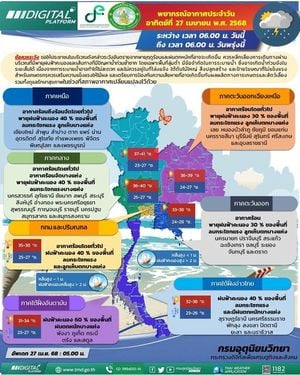As March comes to a close, Germans prepare to spring forward into daylight saving time, a ritual tied to energy conservation and longer evenings. On March 30, 2025, clocks will skip ahead from 2 AM to 3 AM, robbing night owls of an hour of sleep. This annual transition, established in Germany since 1980, continues to spark debate about its relevance and impact on our daily lives.
Initially introduced to save energy in the wake of the 1973 oil crisis, Germany's daylight saving time aims to maximize daylight usage in the evenings. Despite these intentions, the practical benefits of the switch remain under scrutiny. A 2016 report by the Bundestag research committee indicated that Germany actually saves only about 0.2 percent of electricity annually due to this time change, with the savings canceling out in the morning due to increased heating needs. The German Environment Agency remarked, "While daylight saving time reduces electricity usage in the evenings, it results in higher heating costs in the spring and autumn, equating the two."
As millions of clocks spring forward, not all timekeeping devices adjust automatically. The Physikalisch-Technische Bundesanstalt (PTB) in Braunschweig oversees the time transition with atomic clocks and operates a transmitter in Mainflingen, which sends signals to radio clocks across Europe, ensuring their adjustment from a distance. Nevertheless, many generally older devices, such as manual wristwatches and traditional wall clocks, will require a hands-on approach during this change.
Public sentiment towards this seasonal time change is increasingly negative. A survey conducted in February 2023 by DAK revealed that 25 percent of Germans experience physical or psychological issues following the time change, and a striking 76 percent believe the switch is unnecessary, calling for its abolition. Additionally, another survey in Baden-Württemberg in 2024 indicated that 80 percent of respondents deemed the summertime transition redundant.
With these compelling statistics, discussions surrounding the possible cessation of daylight saving time have escalated. The European Union even took steps towards abolishing the bi-annual clock changes, proposing to discontinue the practice in 2018. Despite the European Parliament's vote in favor of the change, implementation has stalled, primarily due to disagreements among member states regarding which time—summer or winter—should be adopted permanently. If the transition is abandoned, each EU nation could individually determine which time will be observed.
Sleep experts advocate for the permanent adoption of winter time, as it more closely aligns with the human biological rhythm. Hans-Günter Weeß, the head of the sleep center at Pfalzklinikum, argues, “We love the long, bright summer evenings, but we must consider that we need darkness to become tired.” The transition leads to conflicts with our natural sleep-wake cycles, with individuals facing the effects of a mini-jetlag as they adjust to the new schedule. Accordingly, the adjustment period extends well beyond just a day; adjusting to the shift in spring typically requires an average of two to three days longer than in autumn.
Furthermore, delaying the onset of morning light can lead to potential dangers on the road. Research has shown an increase in traffic accidents immediately following the transition, likely due to sleep-deprived drivers. Monday following the time change often sees a spike in hospitalizations for cardiovascular issues, underscoring the physical repercussions of losing an hour of sleep.
The 2025 transition to wintertime will revert on October 26, when clocks will once again go back an hour, granting us a brief reprieve. However, the debate remains active regarding the necessity and implications of shifting our clocks twice a year, as well as the potential for a future without this seasonal ritual.
As society continues to evaluate the benefits and drawbacks of daylight saving time, the nuances of human physiology, societal productivity, and environmental impact remain at the forefront of this discussion. Whether the public consensus leads to an abolishment of the practice or the retention of our biannual clock shifting remains to be seen.






